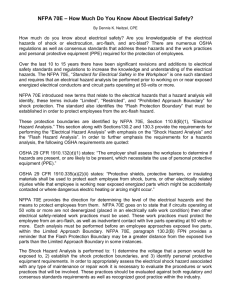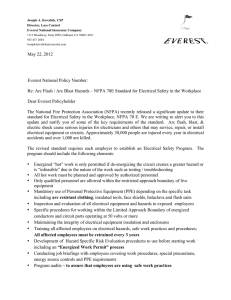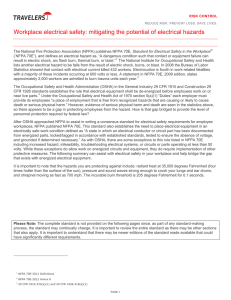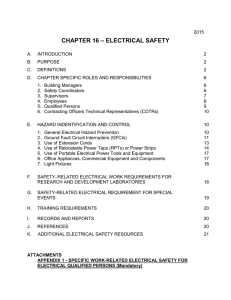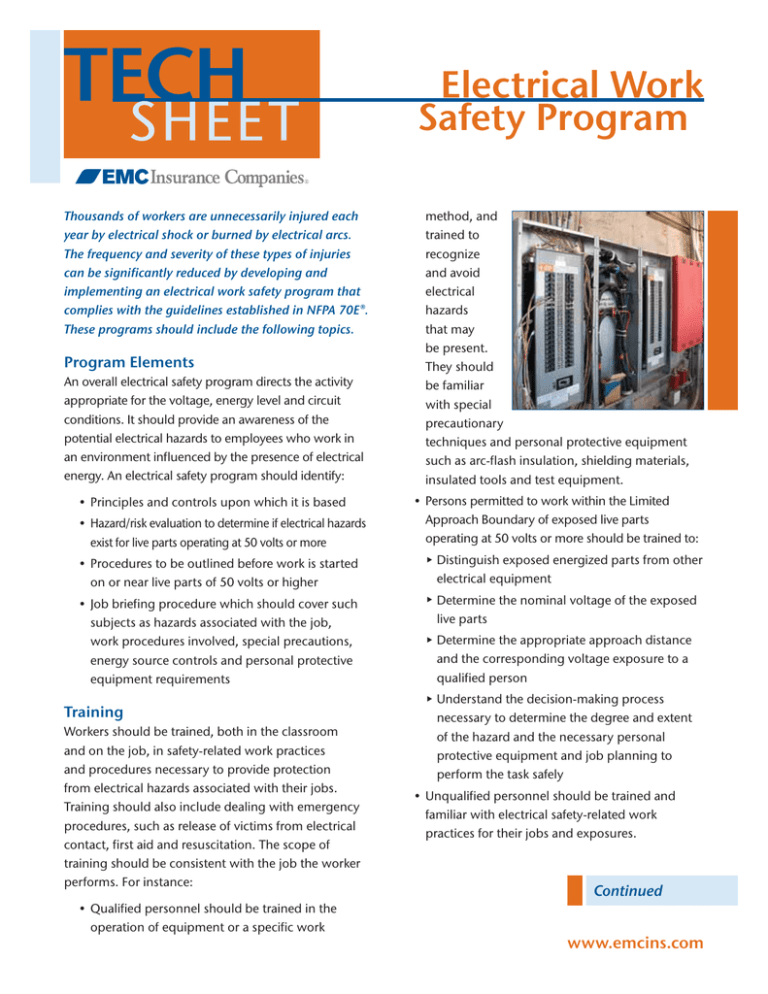
Electrical Work
Safety Program
Thousands of workers are unnecessarily injured each
year by electrical shock or burned by electrical arcs.
The frequency and severity of these types of injuries
can be significantly reduced by developing and
implementing an electrical work safety program that
complies with the guidelines established in NFPA 70E®.
These programs should include the following topics.
Program Elements
An overall electrical safety program directs the activity
appropriate for the voltage, energy level and circuit
conditions. It should provide an awareness of the
potential electrical hazards to employees who work in
an environment influenced by the presence of electrical
energy. An electrical safety program should identify:
• Principles and controls upon which it is based
• Hazard/risk evaluation to determine if electrical hazards
exist for live parts operating at 50 volts or more
method, and
trained to
recognize
and avoid
electrical
hazards
that may
be present.
They should
be familiar
with special
precautionary
techniques and personal protective equipment
such as arc-flash insulation, shielding materials,
insulated tools and test equipment.
• Persons permitted to work within the Limited
Approach Boundary of exposed live parts
operating at 50 volts or more should be trained to:
• Procedures to be outlined before work is started
on or near live parts of 50 volts or higher
f
Distinguish exposed energized parts from other
electrical equipment
• Job briefing procedure which should cover such
subjects as hazards associated with the job,
work procedures involved, special precautions,
energy source controls and personal protective
equipment requirements
f
Determine the nominal voltage of the exposed
live parts
f
Determine the appropriate approach distance
and the corresponding voltage exposure to a
qualified person
f
Understand the decision-making process
necessary to determine the degree and extent
of the hazard and the necessary personal
protective equipment and job planning to
perform the task safely
Training
Workers should be trained, both in the classroom
and on the job, in safety-related work practices
and procedures necessary to provide protection
from electrical hazards associated with their jobs.
Training should also include dealing with emergency
procedures, such as release of victims from electrical
contact, first aid and resuscitation. The scope of
training should be consistent with the job the worker
performs. For instance:
• Qualified personnel should be trained in the
operation of equipment or a specific work
• Unqualified personnel should be trained and
familiar with electrical safety-related work
practices for their jobs and exposures.
Continued
www.emcins.com
Electrical Work
Safety Program
Safe Work Practices for Electrical
Conductors or Circuit Parts
Safety-related work practices should protect workers
from hazards while they are working near exposed
electrical conductors or circuit parts that could
become energized. The following safe work practices
should be followed by all organizations:
• An employee could be exposed to live parts
which should be placed into an electrically safe
work condition before an employee works on
or near these parts, according to NFPA 70E®
Article 120, unless the work on the energized
components can be justified according to NFPA
70E® Article 130.
• Only qualified persons should be permitted to
work on electrical conductors or circuits that have
not been placed into a safe work condition.
• When working on electrical conductors and
circuits of 50 volts or higher that are not in an
electrically safe condition, an electrical hazard
analysis should be completed to develop
procedures that will protect the worker from arc
flash and contact with live parts.
• Appropriate safety-related work practices should
be determined, using both shock hazard analysis
and flash hazard analysis, before any person
approaches exposed live parts within the Limited
Approach Boundary.
• Unqualified persons should not be permitted
to enter spaces that are accessible to qualified
employees, according to NFPA 70E® Article 400.16.
• Only qualified persons with sole control should
be permitted to bypass an electrical safety
interlock, and then only temporarily while that
qualified person is working on the equipment.
For Additional Information
Occupational Safety & Health Administration:
www.osha.gov – Safety/Health Topics
EMC Insurance Companies: www.emcins.com
• Loss Prevention Information Manual
f
Electrical Safety
f
Lockout/Tagout
• Tech Sheets
f
Electrical Hazards
f
Lockout/ Tagout Program
• An Energized Electrical Work Permit should
be completed prior to entering the Limited
Approach Boundary.
Home Office: 717 Mulberry • Des Moines, IA 50309 • 800-447-2295 • www.emcins.com
Disclaimer: This material is designed and intended for general information purposes only, and is not intended, nor shall be construed or relied upon, as specific legal advice.
©Copyright Employers Mutual Casualty Company 2011. All rights reserved. Image ©2011 JupiterImages Corporation.
6167 (12-11)



